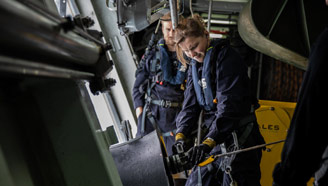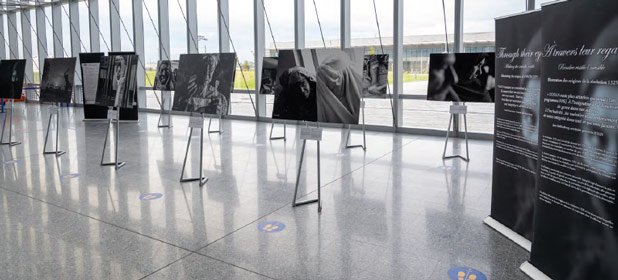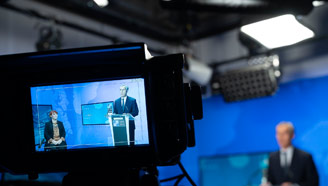NATO & WPS: How an unlikely pair became inseparable
- English
- French
2020 is a big year for Women, Peace and Security. It is the year we celebrate two decades since the first UN Security Council Resolution on WPS recognized the important roles that women play in peace and security. A year to shed light on the many obstacles still in place to women’s full and meaningful participation in security decision-making. And a year to look in earnest at the future of the agenda, including ways to accelerate transformative change.

And as we look ahead it is important to recall where this all began and how we got to where we are today. NATO has had a policy dedicated to the implementation of UNSCR 1325 since 2007, and has considered ways in which the principles of Women, Peace and Security apply to our core business for nearly two decades. The anniversary of UNSCR 1325 provides an opportunity to reflect on how NATO has changed in light of the WPS agenda and to explore how NATO will be advancing this agenda moving forward.
One Resolution that started it all
UNSCR 1325 is the first resolution on Women, Peace and Security, and was unanimously adopted by the UN Security Council on 31 October 2000. That landmark resolution on WPS recognised for the first time the relationship between gender equality and international peace and security. Resolution 1325 specifically addresses how women and girls are differentially impacted by conflict and recognizes the critical role of women in the prevention of violent conflict and the building of sustainable peace. UNSCR 1325 consists of three recognizable pillars: 1) The participation of women in peace building, including enhanced efforts supporting gendered relief and recovery 2) the protection of women and girls from sexual and gender-based violence, and 3) the prevention of the violation of women's rights. Since 2000, nine additional resolutions were adopted to form what is now known as the Women, Peace and Security agenda. Each resolution strengthens the global commitment to the overlooked and undervalued roles of women in the context of conflict and peace.
A role for NATO?
NATO was not originally expected to become a stakeholder in the implementation of UNSCR 1325. The agenda was born in the context of UN peace operations, and championed by women peace activists. But UNSCR 1325 changed the conversation around security and who should be involved. It should come as no surprise, then, that as the broader discussion around women in peace and security developed, NATO began to see how the WPS agenda applied to the Alliance's work.
In pursuit of participation

Well before UNSCR 1325, NATO was working on increasing numbers of women in Allies' armed forces. NATO first addressed the roles of servicewomen in the 1954 Annual Review Committee on National Military Service, and from 1961, regular conferences to address the barriers to women in armed services were held. In 1976, the Committee on Women in NATO Forces was formally established.
The WPS agenda advocates the importance of a meaningful role for women. It is not about parity alone. It is about offering equal opportunities to men and women and about working collectively towards full gender equality.
"Inclusiveness matters. None of the rights women enjoy today were just given, they were fought for and they have to be protected. It is important that women are increasingly present in NATO when discussing different security challenges."
Radmila Šekerinska, Minister of Defence of the Republic of North Macedonia
In that spirit, in the early 2000s, NATO expanded its efforts beyond the focus on women in the military to an attempt to improve the numbers and prospects of women working in its International Staff. NATO agreed its first Equal Opportunities and Diversity Policy in 2003, a guiding document complemented today with diversity and inclusion action plans updated at regular intervals, along with policies on protections against discrimination and harassment.
NATO has a long way to go before it achieves full gender equality, but much has changed in the last twenty years. On the military side, women now make up 12% of Allied national forces – double the percentage of two decades ago. On the International Staff, women make up a larger percentage of staff than ever before – 41% - and in a more diverse set of roles. The number of women in leadership roles has increased over the years and for roles in senior management, we recently reached 30% - often seen as a tipping point for sustained, meaningful change.
Recognizing the roles of women in peace and security should not be limited to women participating in peace processes. Women have a role to play across all aspects of work on peace and security. NATO is committed to creating inclusive environments that support women's full and meaningful participation.
The more you know…
NATO Allies and partners in the Euro-Atlantic Partnership Council developed the Alliance's first policy on WPS in 2007. This first policy was a reflection of NATO's experience with WPS in the years immediately prior – primarily in Afghanistan. Through the NATO-led International Security Assistance Force (ISAF), we were learning how important it was to apply gender perspectives to that operation. We saw that servicewomen deployed with the mission could engage with Afghan communities in ways their male counterparts could not. We also saw how we could contribute to the participation of Afghan women in their own societies, including by providing protection that would enable women to participate in the political process. This experience fed into that first policy in 2007, which was focused on WPS in an operational context, and which saw the work of implementing the WPS agenda for NATO as a task for the military.

Through their eyes – making the invisible visible
At its core, UNSCR 1325 is about making the invisible, visible: it is about opening spaces and dislodging obstacles to women's participation in the decisions around conflict and peace.
Keeping with that important tradition, NATO hosted a photo exhibition by renowned war photographer Sebastian Rich during the second half of October.
The pictures illustrate the origins of UNSCR 1325 and why it marked such an important shift in the global conversation. They remind us that there is no peaceful, prosperous and sustainable world if women's needs, voices and perspectives are not adequately taken into account. The silent yet screaming force of the images displays the human face of the WPS agenda – which often gets lost among lines of text in policy papers. As the security environment changes and increases in its multifaceted complexity, and as NATO adapts to respond to its call to security and stability, this is for us to remember as we move into next 20 years.
Since then, we have come to understand that the principles of WPS apply to everything the Alliance does. That means whatever we do, if it has an impact on people, we need to consider the possible differences in impacts on men and women. This applies to crisis management – as we have seen in Afghanistan, Iraq, and Kosovo, but also to how we provide for the collective defence of NATO members, how we work with partners, how we communicate with the public, and so much more.
Today, our policy on WPS reflects this understanding. Inspired by the ideas underpinning the WPS agenda, our policy today is based on the principles of Integration, Inclusiveness, and Integrity. Integration is about how we include gender in all that we do. Inclusiveness provides for environments in which the full and meaningful participation of women can continue to grow. Integrity ensures that we are upholding the highest standards of behaviour and includes our commitments to protect women and girls from the scourge of conflict-related sexual violence and other threats to their security. In this way, NATO has made the WPS agenda its own.
From principles to the practical
The work of implementing the WPS agenda at NATO requires practical aspects to support it. Some of this comes in the form of policies. Last year, we agreed NATO's first-ever policy on sexual exploitation and abuse. A historic achievement, this new policy applies to all personnel, and defines what behaviours are unacceptable, how to prevent them, and how Allies will work collectively to ensure accountability. We are also working to update and build upon our existing guidelines on preventing and responding to conflict-related sexual violence with a new policy. Watch this space!
Meet NATO's Gender Advisors
Deployed to all NATO commands, missions and operations, NATO Gender Advisors are key for the successful implementation of the Women, Peace and Security agenda. Who are these women and men? What does their daily work look like? And why are they so important to NATO?
Policies are important – and it's always people that carry forward their implementation. NATO's Gender Advisors are essential players in this regard. Part of a large network made up of military and civilian personnel that work across the NATO command structure, the Gender Advisors' responsibility is to deliver advice on the gendered dimensions to all that we do. NATO has proudly deployed Gender Advisors since 2009, and is constantly looking for ways to strengthen the effectiveness of this role.
Accountability is key
This month we established the Leadership Task Force on WPS, chaired by the Deputy Secretary General. The Task Force includes senior managers from the International Staff, International Military Staff, and NATO agencies and provides a forum to address key challenges to implementing the WPS agenda and to explore opportunities for further progress.
It goes without saying that the integration of gender perspectives should not rest on the shoulders of the Gender Advisors alone. To successfully and sustainably integrate gender into all that NATO does requires that people across the organization are involved and understand how this applies to their area of responsibility. This is why we have developed networks of Gender Focal Points. Gender Focal Points are staff members working all across NATO's civilian and military structures that help to ensure gender perspectives are integrated in every policy, programme, and activity that NATO carries out. There are Gender Focal Points working in public diplomacy, operations, intelligence, and defence investment. They work in NATO's Standardization Office and the NATO Communications and Information Agency as well. There really is a gender component to everything we do, and our Gender Focal Points are helping everyone see that. All of this is underpinned by support from leadership across the civilian and military structures.
In a perfect world, everyone would understand why accommodating the different security needs of men and women makes NATO so much more effective and how to do that well. But until the world is perfect, we're committed to providing our teams with the support they need to ensure we're integrating gender perspectives into all our work.
Happy anniversary!

The 20th anniversary of UNSCR 1325 is a great moment to reflect on and discuss what NATO has done, how it could do better, and how to advance this agenda going forward. We are very aware that the security environment within which we are operating is undergoing rapid and unprecedented change.
"Resolution 1325 has had a profound impact worldwide. The principles of Women, Peace and Security have an important contribution to make to NATO's adaptation to a complex and challenging security landscape."
Jens Stoltenberg, NATO Secretary General
Think of climate change, cyber defence, even pandemics – the world is changing and we need to ensure we change with it. That means our work to implement the WPS agenda will continue to evolve as well.
Digital Dialogue on the Future of Women, Peace and Security at NATO
The 20th anniversary of UNSCR 1325 is an opportunity to take an honest look at the future of the WPS agenda, reflecting on ways to ensure the mandate remains fit for purpose and can continue to accelerate transformative change. NATO is and wants to be part of that conversation, in particular as it recently launched the #NATO2030 process to ensure the Alliance remains ready for the challenges of tomorrow. This is why, on 15 October 2020, NATO Secretary General Jens Stoltenberg welcomed Radmila Šekerinska, Melanne Verveer, Robert Egnell, and Kristina Lunz to help us think about how the WPS agenda should evolve and adapt to new security challenges related to climate change, cyber defense, even pandemics. The discussion explored how NATO's approach to WPS should adapt to such change, and identified opportunities to strengthen NATO's role in WPS going forward. Our key take-away? Never stop learning, never stop growing.
To watch the conversation on line, please click here.
We are always on the lookout for great ideas that will help us adapt and be the best security providers we can be. Our new essay series compiles diverse and interesting perspectives on how NATO is to take WPS forward. We also just wrapped up a first conversation with experts on how NATO and WPS are to prepare to respond today to the security challenges of tomorrow.
NATO may not have been front and centre of the Women, Peace and Security agenda in 2000, but we have taken up the mantle and are committed to the advancement of gender equality in the global security architecture. NATO and WPS go hand in hand, and we look forward to building on the successes of the last two decades and to strengthening the role of women in peace and security in the years to come.
